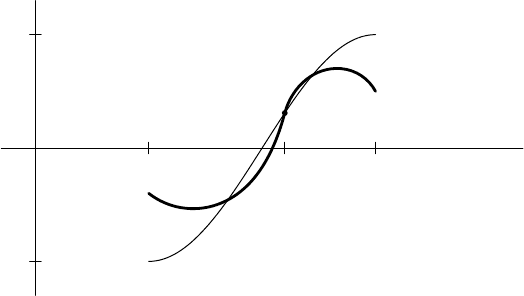Davidson K.R., Donsig A.P. Real Analysis with Real Applications
Подождите немного. Документ загружается.


14.9 Jackson’s Theorem and Bernstein’s Theorem 503
We can make a crude estimate of the error by summing the remaining terms.
°
°
|x| − C
2n
f(x)
°
°
≤
4
π
∞
X
k=n+1
1
4k
2
− 1
kT
n
k
∞
=
2
π
∞
X
k=n+1
1
2k − 1
−
1
2k + 1
=
2
π(2n + 1)
<
1
πn
This may not look very good, since (πn)
−1
tends to 0 so slowly. However, in
1913, Bernstein showed that E
n
(|x|) > 0.1n
−1
for all n. So the Chebychev series
actually gives an approximation of the correct order of magnitude.
Exercises for Section 14.8
A. Let f ∈ C[−1, 1] and g(θ) = f(cosθ). Show that ω(g; δ) = ω(g|
[0,π]
;δ) ≤ ω(f ;δ).
B. Find a sequence of polynomials that converges uniformly to
f(x) =
(
−x
2
for −1 ≤ x ≤ 0
x
2
for 0 ≤ x ≤ 1.
C. Find a continuous function f(x) on [−1, 1] that is not Lipschitz but Φf is Lipschitz in
C[−π, π].
D. Show that there is a constant C so that E
n
(|x|) > C/n.
HINT: See Exercise 14.7.C. Show that
e
E
n
¡
|cos θ|
¢
> (4πn)
−1
by a change of vari-
ables. Now use Theorem 14.8.1.
14.9. Jackson’s Theorem and Bernstein’s Theorem
The goal of this section is to obtain Jackson’s Theorem, which provides a good
estimate of the error of approximation in terms of the smoothness of the function as
measured by the modulus of continuity. First, we will establish a dramatic converse
(for trig polynomials) due to Bernstein in 1912 that the growth of the error function
provides a good measure of the smoothness of the function.
Recall that, for α ∈ (0, 1], we defined the class Lipα as the functions f in
C[a, b] for which there is a constant C with
|f(x) − f(y)| ≤ C|x − y|
α
for all x, y ∈ [a, b].
In particular, Lip1 is the class of Lipschitz functions. Observe that f ∈ Lip α if
and only if ω(f; δ) ≤ Cδ
α
, where ω(f; δ) is the modulus of continuity.
We will use this class to illustrate just how tight these two theorems are. The
following corollary will be deduced from our two main theorems.

504 Fourier Series and Approximation
14.9.1. COROLLARY. Let f be a 2π-periodic function and let 0 < α < 1.
Then f is in Lip α if and only if
e
E
n
(f) ≤ Cn
−α
for n ≥ 1 and some constant C.
Bernstein’s Theorem will be proved first because it is more straightforward.
We begin with an easy lemma. This natural proof uses complex numbers.
14.9.2. LEMMA. Suppose that f, g ∈ TP
n
and f(θ) = g(θ) for 2n + 1 distinct
points in (−π, π]. Then f = g.
PROOF. Let θ
1
, . . . , θ
2n+1
be the common points. Using complex exponentials,
(f − g)(θ) may be expressed as
(f − g)(θ) =
n
X
k=−n
a
k
e
ikθ
= e
−inθ
2n
X
j=0
a
j−n
e
ijθ
.
Now p(z) =
2n
P
j=0
a
j−n
z
j
is a polynomial of degree 2n. Observe that (f − g)(θ) =
e
−inθ
p(e
iθ
). Thus the polynomial p has the roots z
i
= e
iθ
k
for 1 ≤ k ≤ 2n + 1.
These points are distinct because |θ
j
−θ
k
| < 2π if j 6= k. Therefore, p = 0 and so
f = g. ¥
The key to Bernstein’s Theorem is an elegant inequality. The trig polynomial
p(θ) = sinnθ shows that the inequality is sharp (meaning in this case that the
constant cannot be improved).
14.9.3. BERNSTEIN’S INEQUALITY.
Let p be a trigonometric polynomial of degree n. Then kp
0
k
∞
≤ nkpk
∞
.
PROOF. Suppose to the contrary that p ∈ TP
n
but kp
0
k
∞
> nkpk
∞
. By replac-
ing p by λp for a carefully chosen scalar λ, we may arrange that kpk
∞
< 1 yet
n < kp
0
k
∞
= p
0
(θ
0
) for some point θ
0
. Choose the angle γ ∈ [−
π
n
,
π
n
] such that
sinn(θ
0
− γ) = p(θ
0
) and the derivative n cosn(θ
0
− γ) > 0.
Define a trigonometric polynomial in TP
n
by r(θ) = sin n(θ − γ) − p(θ). Set
α
k
= γ +
π
n
(k +
1
2
) for −n ≤ k ≤ n. Observe that r(α
k
) = (−1)
k
−p(α
k
). Since
|p(α
k
)| < 1, the sign of r(α
k
) is (−1)
k
. By the Intermediate Value Theorem, there
are 2n points β
k
with α
k
< β
k
< α
k+1
such that r(β
k
) = 0 for −n ≤ k < n.
The interval (α
s
, α
s+1
) containing θ
0
is special. By choice of γ, sin n(θ − γ) is
increasing from −1 to 1 on this interval. So r(α
s
) < 0 < r(α
s+1
). In addition,
r(θ
0
) = 0 and
r
0
(θ
0
) = n cos n(θ
0
− γ) − p
0
(θ
0
) < 0.
Therefore there are small positive numbers ε
1
and ε
2
such that r(θ
0
− ε
1
) > 0
and r(θ
0
+ ε
2
) > 0. Look at Figure 14.6. Therefore, we may apply the Interme-
diate Value Theorem three times in this interval. Consequently, we can find two

14.9 Jackson’s Theorem and Bernstein’s Theorem 505
θ
α
s
α
s+1
y
1
−1
y = sin(n(θ − γ))
θ
0
y = p(θ)
FIGURE 14.6. The graphs of sinn(θ − γ) and p(θ) on [α
s
, α
s+1
].
additional zeros, so that r has at least 2n + 2 zeros in (α
−n
, α
n
), which is an in-
terval of length 2π. Therefore, by Lemma 14.9.2, we reach the absurd conclusion
that r is identically 0. We conclude that our assumption was incorrect, and in fact
kp
0
k
∞
≤ nkpk
∞
. ¥
We are now in a position to state and prove the desired result. The situation for
α = 1 is more complicated, and we refer the reader to [19]. The meaning of an
error of the form An
−α
for α > 1 will be developed in the Exercises.
14.9.4. BERNSTEIN’S THEOREM.
Let f be a 2π-periodic function such that
e
E
n
(f) ≤ An
−α
for n ≥ 1, where A is a
constant and 0 < α < 1. Then f is in Lip α.
PROOF. Choose p
n
∈ TP
n
so that kf − p
n
k ≤ An
−α
for n ≥ 1. Define q
0
= p
1
and q
n
= p
2
n
− p
2
n−1
for n ≥ 1. Note that
X
n≥0
q
n
(x) = lim
n→∞
p
2
n
(x) = f (x)
uniformly on R. Compute for n ≥ 1,
kq
n
k ≤ kp
2
n
− fk + kf − p
2
n−1
k
≤ A2
−nα
+ A2
−(n−1)α
≤ 3A2
−nα
.
By the Mean Value Theorem and Bernstein’s inequality, we can estimate
|q
n
(x) − q
n
(y)| ≤ kq
0
n
k|x − y|
≤ 2
n
kq
n
k|x − y| ≤ 3A2
n(1−α)
|x − y|.
On the other hand, a simple estimate is just
|q
n
(x) − q
n
(y)| ≤ |q
n
(x)| + |q
n
(y)| ≤ 2kq
n
k ≤ 6A2
−nα
.

506 Fourier Series and Approximation
Splitting the sum into two parts, we obtain
|f(x) − f(y)| ≤
X
n≥0
|q
n
(x) − q
n
(y)|
≤
m−1
X
n=0
3A2
n(1−α)
|x − y| +
X
n≥m
6A2
−nα
≤ 3A|x − y|
2
m(1−α)
− 1
2
1−α
− 1
+ 6A
2
−mα
1 − 2
−α
.
Finally, choose m so that 2
−m
≤ |x − y| < 2
1−m
. Then
|f(x) − f(y)| ≤ 3A2
1−m
2
m(1−α)
(2
1−α
− 1)
−1
+ 6A2
−mα
(1 − 2
−α
)
−1
≤ 6A2
−mα
¡
(2
1−α
− 1)
−1
+ (1 − 2
−α
)
−1
¢
≤ B|x − y|
α
,
where B = 6A
¡
(2
1−α
− 1)
−1
+ (1 − 2
−α
)
−1
¢
. ¥
On the other hand, Jackson’s Theorem shows that smooth functions have better
approximations.
14.9.5. JACKSON’S THEOREM.
Let f belong to C[−1, 1]. Then
E
n
(f) ≤ 6ω(f;
1
n
).
Similarly, if g is a continuous 2π-periodic function,
e
E
n
(g) ≤ 6ω(g;
1
n
).
Notice that we obtain several interesting consequences immediately. This the-
orem shows that Proposition 10.4.4 was the correct order of magnitude, and that
this result is best possible except possibly for improving the constants.
ANOTHER PROOF OF THE WEIERSTRASS APPROXIMATION THEOREM.
Jackson’s Theorem not only proves that every continuous function is the limit of
polynomials, it tells you how fast this happens. It suffices to prove the theorem for
the interval [−1, 1] (see Exercise 10.2.A). In Section 10.4, we used the uniform
continuity of f to show that lim
n→∞
ω(f;
1
n
) = 0. Hence
0 ≤ lim
n→∞
E
n
(f) ≤ lim
n→∞
6ω(f;
1
n
) = 0.
This completes the proof. ¥
Let us apply Jackson’s Theorem to the classes of functions that we have been
discussing.

14.9 Jackson’s Theorem and Bernstein’s Theorem 507
14.9.6. COROLLARY. Let S be the class of functions in C[0, 1] with Lipschitz
constant 1. Then
E
n
(S) ≤
3
n
.
More generally, for Lipschitz constant 1 functions S[a, b] on [a, b],
E
n
(S[a, b]) ≤
3(b − a)
n
.
PROOF. First consider the interval [−1, 1]. For any f in S[−1, 1], we have the
inequality ω(f;
1
n
) ≤
1
n
. Thus by Jackson’s Theorem, E
n
(f) ≤
6
n
.
Now the map
γ(x) =
a + b + (b − a)x
2
for − 1 ≤ x ≤ 1
maps [−1, 1] onto [a, b]. So for any f in C[a, b], the function Γf = f (γ(x)) belongs
to C[−1, 1]. Moreover, if f ∈ S[a, b], then Γf has Lipschitz constant (b − a)/2
(see the Exercises). By the first paragraph, choose a polynomial p of degree n so
that
kΓf − pk
∞
≤ 6
b − a
2
= 3(b − a).
Then
q(x) = Γ
−1
(q) = q(γ
−1
(x)) = p
³
2x − a − b
b − a
´
is the polynomial of degree n such that p = Γq. Thus
kf − qk
[a,b]
= sup
x∈[a,b]
|f(x) − q(x)|
= sup
t∈[−1,1]
|f(γ(t)) − q(γ(t))| = kΓf − pk
∞
≤ 3(b − a).
¥
We complete the proof of Corollary 14.9.1 with the following:
14.9.7. COROLLARY. Suppose that f is a 2π-periodic function of class Lip α
for any 0 < α < 1. Then
e
E
n
(f) ≤ Cn
−α
for n ≥ 1 and some constant C.
PROOF. It is immediate from the condition |f(x) − f(y)| ≤ C|x − y|
α
that
ω(f;
1
n
) ≤ Cn
−α
. Thus Jackson’s Theorem yields
e
E
n
(f) ≤ 6Cn
−α
. ¥
The proof of Jackson’s Theorem is difficult, and it requires a better method of
approximation that is suited to the specific function. The key idea is convolution:
to integrate the function f against an appropriate sequence of polynomials to obtain
the desired approximations. These ideas work somewhat better for periodic func-
tions, so we will use the results of the last section and consider approximation by
trigonometric polynomials instead. Let ψ(θ) = 1 + c
1
cosθ + ··· + c
n
cosnθ. It
will be important to choose the constants c
i
so that ψ is positive. When this is the

508 Fourier Series and Approximation
case, we call ψ a positive kernel function. We will then try to make a good choice
for these constants. For each 2π-periodic function f, define a function
(14.9.8) Ψf(θ) =
1
2π
Z
π
−π
f(θ − t)ψ(t) dt.
We capture the main properties in the following lemma.
14.9.9. LEMMA. Suppose that ψ is a trig polynomial of degree n that is a
positive kernel function on [−π, π]. Define Ψ as in Equation (14.9.8). Then
(1) Ψ1 = 1.
(2) Ψ is linear: Ψ(αf + βg) = αΨf + βΨg for all f, g ∈ C[−1, 1] and
α, β ∈ R.
(3) Ψ is monotone: f ≥ g implies that Ψf ≥ Ψg.
(4) Ψf ∈ TP
n
for all f ∈ C[−1, 1].
PROOF. Part (1) uses the fact that cos nθ has mean 0 on [−π, π].
Ψ1(θ) =
1
2π
Z
π
−π
ψ(t) dt =
1
2π
Z
π
−π
1dt +
n
X
k = 1
c
k
Z
π
−π
cosnt dt = 1
(2) Linearity follows easily from the linearity of the integral.
(3) If h ≥ 0, then since ψ(t) ≥ 0, it follows that Ψh(θ) ≥ 0 as well. Thus if
f ≥ g, then
Ψf − Ψg = Ψ(f − g) ≥ 0.
(4) We make a change of variables by substituting u = θ − t and using the
2π-periodicity to obtain
Ψf(θ) =
1
2π
Z
π
−π
f(θ − t)ψ(t) dt
=
1
2π
Z
θ+π
θ−π
f(u)ψ(θ − u) du =
1
2π
Z
π
−π
f(u)ψ(θ − u) du
=
1
2π
Z
π
−π
f(u) du +
n
X
k=1
c
k
Z
π
−π
f(u) cosk(θ − u) du
=
1
2π
Z
π
−π
f(u) du +
n
X
k=1
c
k
Z
π
−π
f(u)
¡
coskθ cosku + sin kθ sin ku
¢
du
= A
0
+
n
X
k=1
2c
k
A
k
coskθ + 2c
k
B
k
sinkθ,
where A
k
and B
k
are the Fourier coefficients of f. This shows that Ψf is a trig
polynomial of degree at most N. ¥

14.9 Jackson’s Theorem and Bernstein’s Theorem 509
Notice that Φf is a trigonometric polynomial that is a weighted linear combi-
nation of the Fourier coefficients of f much like the Ces
`
aro means. The positivity
of the kernel means that the error estimates can be made in much the same way.
However, a more clever choice of the weights c
i
will result in a better estimate.
14.9.10. LEMMA. If f is a continuous function on [a, b], then for any t > 0,
ω(f; t) ≤
³
1 +
t
δ
´
ω(f; δ).
PROOF. Suppose that (n − 1)δ < t ≤ nδ. Then if |x − y| ≤ t, we may find points
y = x
0
< x
1
< ··· < x
n
= x such that |x
k
− x
k−1
| ≤ δ for 1 ≤ k ≤ n. Hence
|f(x) − f(y)| ≤
n
X
k=1
|f(x
k
) − f (x
k−1
)|
≤ nω(f; δ) ≤
¡
1 +
t
δ
¢
ω(f; δ).
Taking the supremum over all pairs x, y with |x − y| ≤ t yields
ω(f; t) ≤
³
1 +
t
δ
´
ω(f; δ).
¥
14.9.11. LEMMA. Suppose that f ∈ C[−π, π] is a 2π-periodic function. Let
ψ =
P
n
k=0
c
k
coskθ be a positive kernel function of degree n. Then
kΨf − fk
∞
≤ ω(f;
1
n
)
¡
1 +
πn
2
p
2 − c
1
¢
.
PROOF. Apply the previous lemma with δ = 1/n to obtain
|f(θ − t) − f (θ)| ≤ ω(f ;|t|) ≤ (1 + n|t|) ω(f;
1
n
).
Now using the integral formula for Ψf,
¯
¯
Ψf(θ) − f(θ)
¯
¯
=
¯
¯
¯
¯
1
2π
Z
π
−π
f(θ − t)ψ(t) dt − f(θ)
1
2π
Z
π
−π
ψ(t) dt
¯
¯
¯
¯
≤
1
2π
Z
π
−π
¯
¯
f(θ − t) − f (θ)
¯
¯
ψ(t) dt
≤
1
2π
Z
π
−π
(1 + n|t|) ω(f;
1
n
)ψ(t) dt
= ω(f;
1
n
)
µ
1 +
n
2π
Z
π
−π
|t|ψ(t) dt
¶
.

510 Fourier Series and Approximation
To estimate this last term, we need the Cauchy–Schwarz inequality for integrals
(Corollary 7.3.5).
1
2π
Z
π
−π
|t|ψ(t) dt =
1
2π
Z
π
−π
¡
|t|ψ(t)
1/2
¢
ψ(t)
1/2
dt
≤
µ
1
2π
Z
π
−π
t
2
ψ(t) dt
¶
1/2
µ
1
2π
Z
π
−π
ψ(t) dt
¶
1/2
The second integral is just 1.
Recall the easy estimate sinθ ≥ 2θ/π for 0 ≤ θ ≤ π/2. This yields
1 − cos t = 2sin
2
t
2
≥ 2
4
π
2
µ
t
2
¶
2
=
2
π
2
t
2
for − π ≤ t ≤ π.
Substitute this back into our integral:
1
2π
Z
π
−π
t
2
ψ(t) dt ≤
1
2π
Z
π
−π
π
2
2
(1 − cos t)ψ(t) dt
=
π
2
2
µ
1
2π
Z
π
−π
ψ(t) dt −
1
2π
Z
π
−π
ψ(t) cost dt
¶
=
π
2
2
(1 −
c
1
2
)
Therefore, we obtain
¯
¯
Ψf(θ) − f(θ)
¯
¯
≤
³
1 +
nπ
2
p
2 − c
1
´
ω(f;
1
n
).
¥
PROOF OF JACKSON’S THEOREM. This lemma suggests trying to minimize
2 − c
1
over all positive kernel functions of degree n. The most straightforward
method is to write down a kernel that gets excellent estimates. Consider the com-
plex trig polynomial
p(θ) =
n
X
k=0
a
k
e
ikθ
=
n
X
k=0
sin
(k+1)π
n+2
e
ikθ
.
Our kernel will be ψ(θ) = c|p(θ)|
2
. The constant c is chosen to make the constant
coefficient equal to 1. Positivity of ψ is automatic since it is the square of the
modulus of p. It remains merely to do a calculation to determine the coefficients.
First, we compute
|p(θ)|
2
=
n
X
j=0
a
j
e
ijθ
n
X
k=0
a
k
e
−ikθ
=
n
X
j=0
n
X
k=0
a
j
a
k
e
i(j−k)θ
=
n
X
j=0
a
2
j
+
n
X
s=1
n−s
X
k=0
a
k
a
k+s
¡
e
isθ
+ e
−isθ
¢
= b
0
+
n
X
s=1
2b
s
cossθ,

14.9 Jackson’s Theorem and Bernstein’s Theorem 511
where b
s
=
n−s
P
k=0
a
k
a
k+s
for 0 ≤ s ≤ n. We choose c = 1/b
0
=
¡
n
P
j=0
a
2
j
¢
−1
. It is
clear that ψ is a cosine polynomial of degree n with constant coefficient equal to 1.
So ψ is a positive kernel function.
So now we compute the coefficient b
1
. We use some clever manipulations and
the identity sin A + sinB = 2sin
A+B
2
cos
A−B
2
. Notice that the periodicity of the
coefficients is used in the second line.
2b
1
= 2
n−1
X
k=0
a
k
a
k+1
=
n−1
X
k=0
2sin
(k+1)π
n+2
sin
(k+2)π
n+2
=
n
X
k=1
2sin
kπ
n+2
sin
(k+1)π
n+2
=
n−1
X
k=0
2sin
kπ
n+2
sin
(k+1)π
n+2
=
n−1
X
k=0
sin
(k+1)π
n+2
³
sin
(k+2)π
n+2
+ sin
kπ
n+2
´
= 2
n−1
X
k=0
sin
2
(k+1)π
n+2
cos
π
n+2
= 2b
0
cos
π
n+2
Hence
c
1
=
2b
1
b
0
= 2 cos
π
n + 2
.
So
1 +
nπ
2
p
2 − c
1
= 1 +
nπ
2
r
2 − 2 cos
π
n + 2
= 1 +
nπ
2
2sin
π
2(n + 2)
≤ 1 + nπ
π
2(n + 2)
< 1 +
π
2
2
< 6.
The proof is now completed by appealing to Lemma 14.9.11. ¥
Exercises for Section 14.9
A. Suppose that f in C[a, b] has Lipschitz constant L. Let γ(x) = Ax + B. Show that
f(γ(x)) has Lipschitz constant AL.
B. Suppose that f is a 2π-periodic function such that
e
E
n
(f) ≤ Cn
−p−α
, where p ∈ N
and 0 < α < 1. Prove that f is C
p
and that f
(p)
is in the class Lipα as follows.
(a) Write f as a sum of the polynomials q
n
as in the proof of Bernstein’s Theorem.
Apply Bernstein’s inequality p times to the q
n
’s. Show that the resulting series of
derivatives still converges, and deduce that f is C
p
.
(b) Use this series to show that
e
E
n
(f
(p)
) ≤ C
0
n
−α
. Then finish the argument.

512 Fourier Series and Approximation
C. (a) Suppose that f is C
1
on [−1, 1] and kf
0
k
∞
= M. Show that E
n
(f) ≤
6M
n
.
(b) Now choose a polynomial p of degree n − 1 so that kf
0
− pk
∞
= E
n−1
(f
0
). Let
q(x) =
Z
x
0
p(t) dt. Show that E
n
(f) = E
n
(f − q) ≤
6
n
E
n−1
(f
0
).
D. (a) Use induction on the previous exercise to show that if f has k continuous deriva-
tives on [−1, 1], then for n > k,
E
n
(f) ≤
6
k
n(n − 1) ···(n + 1 −k)
E
n−k
(f
(k)
).
(b) Hence show that there is a constant C
k
so that for n > k.
E
n
(f) ≤
C
k
n
k
ω
³
f
(k)
;
1
n − k
´
Find this constant explicitly for k = 2.
E. Do a change of variables in the previous exercise to show that if f has k continuous
derivatives on [a, b], then for n > k.
E
n
(f) ≤
C
k
(b − a)
k
n
k
ω
³
f
(k)
;
b − a
2(n − k)
´
F. Show that if f is a 2π-periodic function and
e
E
n
(f) ≤ C/n, then ω(f;δ) ≤ Bδ|logδ|.
HINT: Study the proof of Bernstein’s Theorem using α = 1.
G. Prove the Dini–Lipschitz Theorem: If f is a continuous function on [−1, 1] such that
lim
n→∞
ω(f;
1
n
) logn = 0, then the Chebychev series C
n
f converges uniformly to f.
HINT: Combine Jackson’s Theorem with Theorem 14.8.2.
H. Let 0 < α < 1.
(a) Show that f(x) = |x|
α
belongs to Lipα.
(b) Modify the proof of Proposition 10.4.4 to obtain a lower bound for E
n
(Lipα).
HINT: Piece together translates of |x|
α
.
